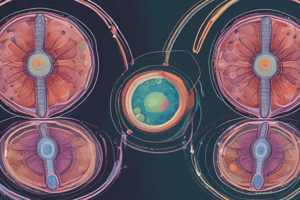Podcast
Questions and Answers
What is the first stage of Mitosis where chromatin condenses into chromosomes and the nucleolus disappears?
What is the first stage of Mitosis where chromatin condenses into chromosomes and the nucleolus disappears?
- Anaphase
- Metaphase
- Telophase
- Prophase (correct)
During which stage do chromosomes break at the centromeres and sister chromatids move to opposite ends of the cell?
During which stage do chromosomes break at the centromeres and sister chromatids move to opposite ends of the cell?
- Prophase
- Anaphase (correct)
- Metaphase
- Telophase
Which phase involves chromosomes aligning along the equatorial plane of the mitotic spindle?
Which phase involves chromosomes aligning along the equatorial plane of the mitotic spindle?
- Metaphase (correct)
- Anaphase
- Telophase
- Prophase
What phase is marked by the decondensation of chromosomes and the reformation of the nuclear envelope?
What phase is marked by the decondensation of chromosomes and the reformation of the nuclear envelope?
Which phase of the cell cycle is characterized by the replication of genomic DNA within the nucleus?
Which phase of the cell cycle is characterized by the replication of genomic DNA within the nucleus?
Which phase occurs immediately after the DNA has been replicated, preparing for cell division?
Which phase occurs immediately after the DNA has been replicated, preparing for cell division?
What occurs in the G1 Phase of the cell cycle?
What occurs in the G1 Phase of the cell cycle?
Which of the following statements best describes the function of the centromere during Mitosis?
Which of the following statements best describes the function of the centromere during Mitosis?
What occurs during synapsis in meiosis?
What occurs during synapsis in meiosis?
Which phase of meiosis is characterized as the longest and most complex?
Which phase of meiosis is characterized as the longest and most complex?
What is the role of the synaptonemal complex during meiosis?
What is the role of the synaptonemal complex during meiosis?
During which phase of meiosis do tetrads align at the metaphase plate?
During which phase of meiosis do tetrads align at the metaphase plate?
What is a chiasma in the context of meiosis?
What is a chiasma in the context of meiosis?
During Anaphase I of meiosis, what happens to homologous chromosomes?
During Anaphase I of meiosis, what happens to homologous chromosomes?
What distinguishes meiosis from mitosis in terms of chromosome number?
What distinguishes meiosis from mitosis in terms of chromosome number?
Which of the following terms refers to the paired homologous chromosomes that form during meiosis?
Which of the following terms refers to the paired homologous chromosomes that form during meiosis?
What occurs during Telophase I of meiosis?
What occurs during Telophase I of meiosis?
What is the purpose of interkinesis in meiosis?
What is the purpose of interkinesis in meiosis?
What happens during Metaphase II of meiosis?
What happens during Metaphase II of meiosis?
What is true about the daughter cells produced at the end of Telophase II?
What is true about the daughter cells produced at the end of Telophase II?
What is a primary spermatocyte?
What is a primary spermatocyte?
What do primary oocytes form after puberty?
What do primary oocytes form after puberty?
Which of the following statements about Meiosis II is accurate?
Which of the following statements about Meiosis II is accurate?
What role does crossing over play in Meiosis I?
What role does crossing over play in Meiosis I?
Flashcards are hidden until you start studying
Study Notes
Mitosis
- Parent cell divides into two daughter cells with the same number of chromosomes.
- During mitosis, chromosomes are duplicated, and sister chromatids are separated.
- Cells go through four stages: prophase, metaphase, anaphase, and telophase.
- Mitosis leads to cell growth, repair, and development.
Meiosis
- A type of cell division that produces gametes (sex cells) with half the number of chromosomes as the parent cell.
- There are two rounds of division: Meiosis I and Meiosis II.
- The main purpose of meiosis is to create genetic diversity in offspring.
Meiosis I - Homologous Chromosomes Separation
- Includes prophase I, metaphase I, anaphase I, and telophase I.
Prophase I
- The longest and most complex stage of meiosis.
- Synapsis occurs: Homologous chromosomes pair up to form tetrads.
- Chiasmata: Crossing over between non-sister chromatids during synapsis, leading to genetic recombination.
Metaphase I
- Tetrads align at the metaphase plate, ensuring independent assortment of chromosomes.
Anaphase I
- Homologous chromosomes separate and move to opposite poles.
- Sister chromatids remain attached.
Telophase I
- Usually simultaneous with cytokinesis.
- Two haploid daughter cells are formed.
- Each daughter cell has one chromosome from each homologous pair.
Interkinesis
- A short period of rest between Meiosis I and Meiosis II.
- No DNA replication during interkinesis.
Meiosis II - Sister Chromatids Separation
- Includes prophase II, metaphase II, anaphase II, and telophase II.
Prophase II
- New spindle apparatus forms.
- Similar to mitosis prophase, but with haploid number of chromosomes.
Metaphase II
- Chromosomes align at the metaphase plate.
- Sister chromatids are not genetically identical due to crossing over in Meiosis I.
Anaphase II
- Sister chromatids separate and move to opposite poles.
- Breakdown of proteins holding sister chromatids at the centromere allows separation.
Telophase II
- Nuclei form, chromosomes de-condense, and cytokinesis occurs.
- Four haploid daughter cells are formed, each unique and different from the parent cell.
Gametogenesis: Spermatogenesis and Oogenesis
- The process of forming gametes (sperm and eggs).
Spermatogenesis
- Starts with diploid spermatogonia.
- Spermatogonia undergo mitotic division.
- Primary spermatocyte: diploid.
- Secondary spermatocyte: haploid.
- Spermatozoa: fully mature, motile sperm ready for fertilization.
Oogenesis
- All primary oocytes form by the fifth month of fetal life.
- After puberty, meiosis continues, forming secondary oocytes.
- Resulting in 3 polar bodies and one ovum (egg).
Studying That Suits You
Use AI to generate personalized quizzes and flashcards to suit your learning preferences.



